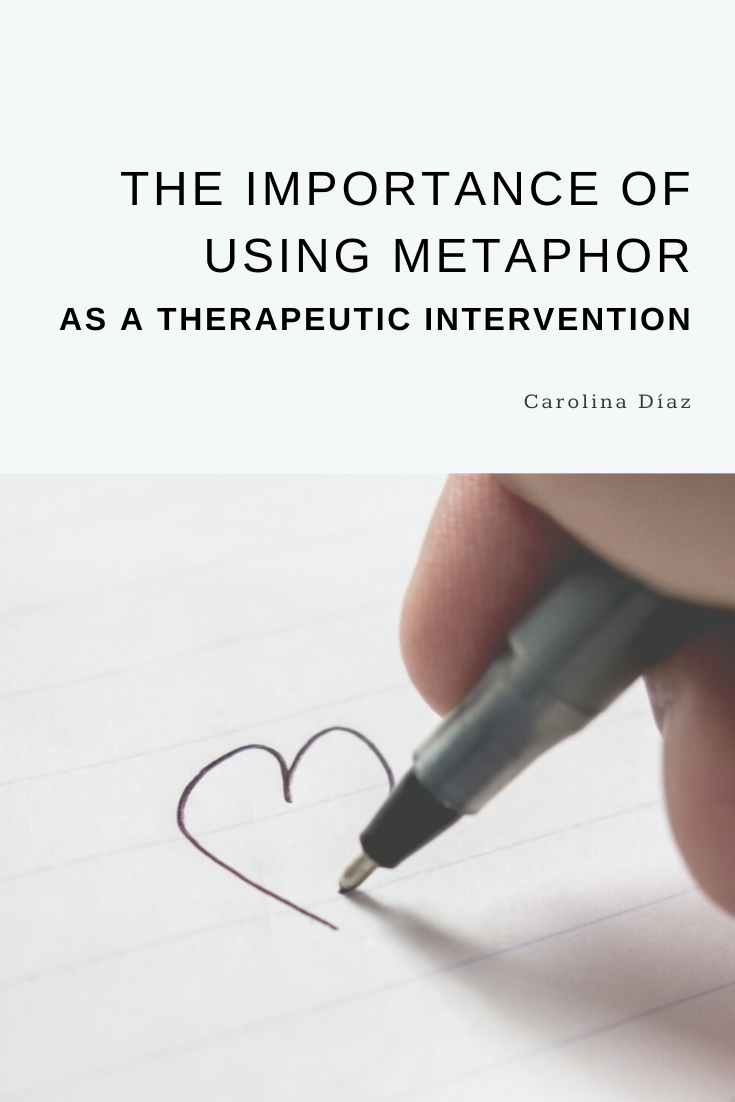Metaphor is a figure of speech that consists of naming, describing, or qualifying something through its similarity or analogy to something else. It’s not just about songwriting or poetry-- we use metaphors all the time. After all, we all “fall in love” or “get stuck” at some point in our lives.
In the psychoanalytic approach, metaphors have always been very important, since the unconscious mind is linked to an encryption-decryption operation. Sometimes, metaphors can be seen in a client’s symptom, especially when it comes to psychosomatic manifestations. Like Freud’s famous case in which his patient Dora suffers from, among many other symptoms, limping. Not finding any organic cause for this, Freud decides to read this leg-dragging as "making a false step". It turns out that Dora had responded to Mr. K’s flirtatious advances with a slap. However, according to Freud, in the dragging of her foot, the unconscious desire to make a false step (by having a romantic relationship with Mr. K) is revealed. Dora’s misstep, in this example, is a metaphor expressed in her body.
Metaphoric language used by the client
Although envisioning symptoms as metaphors is not everyone’s cup of tea, we can still see how important it becomes to pay close attention to the information we’re given by our patients.
Koppe (1995), explains:
“Entering the domain of metaphoric imagery requires a shift in attention from the logical meaning associated with the content of communication to the metaphoric meaning associated with the metaphoric image (i.e., "hitting my head against a wall," a "balloon," "opening a can of worms," etc.). This shift invites clients (and therapists) to pause for a moment and, like Alice entering a land of wonder through the window of her looking glass, wander awhile in the sensory-imaginal world of March Hares and Mad Hatters.”
Regardless of therapeutic approach, it’s well acknowledged that speech is a fundamental part of therapy. By paying attention to the metaphors clients use to describe their thoughts and feelings, the therapist is able to listen to something else. That is, something that also reflects the client’s own perceptions of what is going on. Therefore, we should pay attention to the metaphors that patients use spontaneously. For example: A patient that describes her romantic partner as a “pet”. That simple word already tells us something important about the relationship and how the client perceives not only their partner’s role, but their own.
Metaphors in the therapeutic intervention
Jorge Bucay, an acclaimed Argentinian psychotherapist, often uses metaphoric stories and revisited classic tales in his interventions. When asked in an interview: What do stories bring to a person in need of psychological help? He replied:
"A wisdom of centuries, the wisdom of others who have passed through this place and solved it in different ways. Telling a story is like saying, look, there's someone else who found this way out, why don't you try it?"
In his book “Déjame que te cuente” (Let me tell you), Bucay clarifies:
“I realized that, with my patients, I had often resorted to this way of saying what I wanted. I noticed how my patients remembered my stories more than my interpretations, exercises, or comments. I remembered the profound impact of the stories from the Eriksonian model. I realized, in short, that I was increasingly using a powerful didactic and, of course, therapeutic weapon.”
The use of metaphors in the psychotherapeutic context can be powerful. Metaphors can be used as an indirect intervention to communicate certain issues that, said otherwise, might be received with rejection, or, on the other hand, may be too abstract to be remembered by the patient. Using metaphors and metaphoric stories is a helpful technique that has the power to evoke images. In other words, metaphors can lead the way to a symbolic understanding of the clients issues and their possibilities to take action.
Metaphors allow us to obtain essential information in an indirect way. And often, they speak louder and clearer than elaborate explanations could. On this subject, Ibáńez (1997) points out that metaphors evoke, better than the wisest reasoning, the undefinable that lives in family relationships and their usual courtship of love, hate, fidelity, betrayal, sadness, and so on.
An Invitation
As therapists, it’s important to create a curated collection of tales, short stories, and poems. They might get used as a therapeutic technique, or they might enrich our understanding of the metaphors being spoken by our clients. Either way, cultivating and expanding our figurative vocabulary can provide a great deal of value to our interventions.
Our profession, in many ways, is about hearing stories, sometimes telling them and, most of the time, leading the way for our clients to rewrite them. Ending long traumatic tales. Starting new promising ones. We’re all poems and poets, before being therapists and clients. Allowing ourselves to delve in diverse imagery can enrich our skillset. And even if we love (and have to keep up with) textbooks and clinical trials, it’s important to give metaphors and poetry their place in our practice.
References
Bucay, J. (2005). Déjame que te cuente. RBA.
Gil Ibáñez, A. (1997). La metáfora como instrumento terapéutico. Redes: revista de psicoterapia relacional e intervenciones sociales. Vol. 2, Nº. 1 ( 71-84). Retrieved from: https://redesdigital.com.mx/index.php/redes/article/download/149/88
Kopp, R. R. (1995). Metaphor therapy: Using client-generated metaphors in psychotherapy. Brunner/Mazel.
Roilidou, S. (2019). Entrevista al Dr. Jorge Bucay para ispania.gr. Retrieved from: https://www.ispania.gr/arthra/logotexnia/5932-entrevista-bucay-ispania-gr
*This post contains Amazon affiliate links. If you choose to purchase a resource via our link, we receive a small amount of your purchase to help support our work. See our affiliate policy for more information.
The Author
Carolina Díaz is a psychotherapist who also loves to teach. She has Master’s Degrees in Psychoanalysis and Culture’s Philosophy, as well as Clinical Psychopedagogy. Before working online, Carolina worked as a school psychologist and had her own private practice for adults. She offers online counseling and writes about mental health on her website: www.carolinadiazruiz.com.
Let’s Chat
Let us know in the comments below:
How and when do you use metaphors in therapy?
What one thing are you taking away from this article that will be useful to your practice?
Interested in free downloads? Sign up for our resource library, below:














